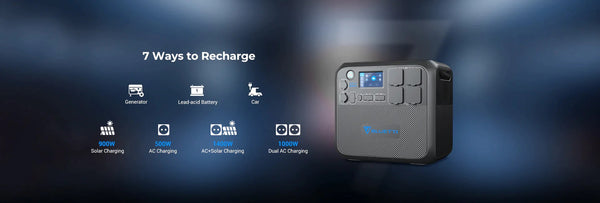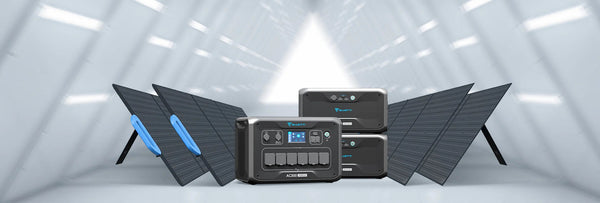When embarking on van life or converting a van into a mobile home, one essential consideration is your electrical system. An integral part of this system is the inverter, which converts DC power from your van's batteries into AC power for running household appliances and devices. In this guide, we'll explore everything you need to know about selecting the right inverter for van, from understanding the types of inverters to sizing, and installation.

What is an Inverter for a Van?
An inverter for van is a vital component of your electrical setup. It allows you to power household appliances and electronics that typically run on AC on the road or off-grid. Inverters come in various types, and understanding the differences is crucial to making an informed choice.
Commons between Pure Sine Wave Inverters and Modified Sine Wave Inverters
Pure sine wave and modified sine wave inverters share common functions as both convert DC power to AC power, making them suitable for various applications, from off-grid living to powering standard appliances. They come in portable and versatile designs, catering to diverse power needs in settings such as van conversions, RVs, boats, and more.
Both types of inverters are used to operate everyday household appliances and electronic devices, including lighting, laptops, televisions, and kitchen appliances, providing users with flexibility and convenience in choosing their power source.
Differences between Pure Sine Wave Inverters and Modified Sine Wave Inverters
The primary distinction between pure sine wave and modified sine wave inverters lies in the type of AC waveform they produce. Pure sine wave inverters replicate the smooth, sinusoidal waveform found in utility grid power, making them the choice for devices requiring high-quality, distortion-free power like sensitive electronics and medical equipment.
In contrast, modified sine wave inverter for van produce a stepped or stair-like waveform, which may only be compatible with some devices. Some electronics, audiovisual equipment, and appliances with electric motors might experience efficiency or operational issues when connected to modified sine wave inverters, making it crucial to consider the specific needs of your devices when selecting an inverter type.
What Size Inverter Do I Need for a Van?
Selecting the right size power inverter for van is crucial to ensure it meets your power requirements without straining your van's electrical system. The answer to this question is straightforward: your inverter should have a slightly higher capacity than the most power-hungry electrical device you intend to use. For instance, if you plan to operate a device that consumes 1800 watts, you should acquire a 2000-watt inverter.
If you've conducted a thorough power audit, you'll recall that the calculator typically suggests an appropriate inverter size based on your provided information.
For typical household applications, like powering household coffee makers, toasters, hair dryers, and other common yet power-demanding devices, a 2000-watt inverter is recommended. This capacity allows the inverter to handle approximately 15 amps of continuous AC power, similar to a standard 15 amp household circuit.
How to Install an Inverter in a Van?
Installing a power inverter for van involves several steps. Here is how you can do it:
Step 1: Choose the Right Location
Select a suitable location for your inverter. It should be in a well-ventilated area, protected from moisture, and easily accessible for maintenance. Ensure there's enough space for proper airflow and that it's close to your battery bank to minimize cable length.
Step 2: Disconnect Power Sources
Before starting, disconnect any power sources, including the van's battery. It ensures your safety while working on the electrical system.
Step 3: Install the Inverter
Mount the inverter securely to your chosen location using appropriate hardware. Ensure it's level and stable.
Step 4: Connect the DC Cables
Connect the positive (red) DC cable from the inverter for van to the positive terminal of your battery bank. Use an appropriate gauge cable to handle the inverter's power demands. Similarly, connect the negative (black) DC cable to the negative terminal.
Step 5: Connect the AC Cables
Connect the AC output of the inverter to your AC distribution system or outlets. Use appropriately sized AC cables for this connection. Ensure you follow the correct wiring color codes (usually black for hot, white for neutral, and green or bare for ground).
Step 6: Ground the Inverter
Connect the inverter's grounding lug to a suitable grounding point in your van. It is typically a metal chassis member. Ensure a solid and clean connection to establish a proper ground.?
Best 3 Inverter+Battery Kits for a Van
Now, let's introduce you to three outstanding BLUETTI inverter+battery kits that can take your van's electrical system to the next level:
BLUETTI AC200P+3*PV200 Solar Generator Kit:
The BLUETTI AC200P+3*PV200 Solar Generator Kit is a powerhouse inverter and battery combination designed to provide ample electrical power for your van conversion or outdoor adventures. A robust 2,000Wh/2,000W pure sine wave inverter kit for van can handle various appliances and electronics, including power-hungry devices.
One standout feature of this kit is its flexibility in recharging options. It can be replenished through various means, including AC power, solar panels, your van's battery, a generator, and a lead-acid battery. This versatility ensures you'll have power sources available no matter where you are, reducing your reliance on traditional grid electricity.

The kit's smart touchable interaction LCD makes monitoring your power usage and available capacity a breeze. Additionally, it boasts rapid recharge capabilities, with 700W solar and 500W AC recharge in as little as 2-2.5 hours. This quick replenishment means you spend less time waiting for power and more time enjoying your van life adventures.
Moreover, the BLUETTI AC200P is an eco-friendly solution, running quietly without gas or other fossil fuels. It reduces your environmental footprint and makes for a more peaceful and enjoyable outdoor experience. Overall, this kit is a fantastic choice for those seeking a powerful and eco-conscious inverter kit for van and battery setup for their van.
BLUETTI AC200MAX+PV350 Solar Generator Kit:
The BLUETTI AC200MAX+PV350 Solar Generator Kit is an excellent option for those who demand even more power and expandability. With a 2,048Wh capacity and a pure sine wave inverter for van delivering 2,200W (4,800W surge), this kit can handle many appliances and devices, making it ideal for extended van journeys or off-grid living.
One of the standout features of this kit is its expandability. You can add up to two battery modules (B230 or B300) to increase your power storage capacity. It allows you to tailor your energy supply to your needs, ensuring sufficient power for longer trips or periods off-grid.

The kit also features a high solar input rate, allowing for efficient solar charging. With up to 900W of solar input capacity, you can quickly harness the sun's energy to replenish your power reserves. Smart app control and monitoring also provide real-time data and control over your electrical system.
The BLUETTI AC200MAX+PV350 Solar Generator Kit is built to last, with a long-life LFP battery capable of 3,500+ charge cycles to 80% capacity. This durability ensures that your investment will continue to serve you well for years, making it an excellent choice for those who prioritize longevity and expandability in their van's power system.
BLUETTI AC300+B300+PV350 Solar Generator Kit:
The BLUETTI AC300+B300+PV350 Solar Generator Kit is a top-tier choice for those needing an even more substantial power supply. With a 3,072Wh capacity and a powerful 3,000W pure sine wave inverter (6,000W surge), this kit can handle your van conversion's most demanding electrical needs.
One of its key advantages is its expandability. You can add up to four B300 battery modules to achieve an impressive 12,288Wh of power storage. This capacity level is ideal for van lifers who require a significant and reliable power source for extended periods off-grid or as a backup power solution for their homes.

The kit offers seven ways to recharge, including solar, AC power, your vehicle's battery, a generator, and more. This flexibility ensures you're always in power, regardless of location or circumstances. The smart app control and monitoring features also provide real-time insights into your power usage and allow for convenient management.
The BLUETTI AC300+B300+PV350 Solar Generator Kit is powerful and dependable, serving as a 24/7 UPS home backup system, ensuring you have reliable power in emergencies. With a 4-year worry-free warranty, you can have peace of mind knowing your investment is protected.
FAQs about Inverter for A Van
How long will a 12V battery last with an inverter?
The duration a 12v to 240v inverter for van battery will last with an inverter depends on factors such as the battery's capacity (measured in ampere-hours or Ah), the inverter's efficiency, and the load (wattage of the devices) being powered. To estimate battery life, you can divide the battery's capacity (in Ah) by the load's power consumption (in watts). For instance, a 100Ah battery and a 300W load could last approximately 3.3 hours (100Ah / 300W = 0.33 hours or 20 minutes). Remember, it's vital to avoid discharging a lead-acid battery below 50% to prolong its lifespan so that factor should be considered in your calculations.
What do you need an inverter for in a van?
An inverter in a van is necessary for converting the DC (Direct Current) power from the van's batteries (typically 12V or 24V) into AC (Alternating Current) power, typically at 120V or 230V. This conversion lets you operate household appliances and electronic devices connected to a standard electrical outlet, such as laptops, lights, kitchen appliances, and entertainment systems. Inverters are indispensable for van life, allowing you to enjoy the comforts of home while on the road or off-grid.
What is the most efficient inverter for a van?
The most efficient inverter for a van is typically a pure sine wave inverter. Pure sine wave inverters produce high-quality AC power that resembles the utility grid's electricity. It ensures compatibility with various appliances and devices, including sensitive electronics. Although modified sine wave inverters are more affordable, they may only be as efficient and compatible with some devices. Efficiency is also influenced by the inverter's size relative to your power needs, so selecting the right size is crucial for efficiency.
Conclusion
Selecting the right inverter for your van is a critical decision that impacts your comfort and convenience on the road. You can make an informed choice by understanding the types of inverters, sizing considerations, and installation steps and exploring top-notch options like BLUETTI inverter + battery kits. With the right inverter, you'll have a reliable power source to fuel your adventures in van life.



